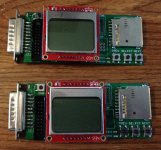Trash80toHP_Mini
NIGHT STALKER
In the process of disassembling a DOA Plus Mobo for a hack, I discovered a ready source for the elusive DB-19 connector. From now on, any MoBos blessed with the presence of this connector that have suffered particularly nasty forms of failure, such as irreparable cap leakage, should donate this connector to the cause before being recycled responsibly.
Desoldering is not even necessary, just donate the boards to the cause. Harvesting the SCSI Controller would for re-use would be an excellent organ for transplanting in the case of comrades doing the internal SCSI hack of the Plus.
I've got a bandsaw for rough cutting these parts for storage until requested by other comrades, PM me if you have prospective organ donors on hand. If you have any suggestions for other parts that should be kept in ZipLoc bags until needed, let me know. SIMM connectors come to mind as well.
Desoldering is not even necessary, just donate the boards to the cause. Harvesting the SCSI Controller would for re-use would be an excellent organ for transplanting in the case of comrades doing the internal SCSI hack of the Plus.
I've got a bandsaw for rough cutting these parts for storage until requested by other comrades, PM me if you have prospective organ donors on hand. If you have any suggestions for other parts that should be kept in ZipLoc bags until needed, let me know. SIMM connectors come to mind as well.


